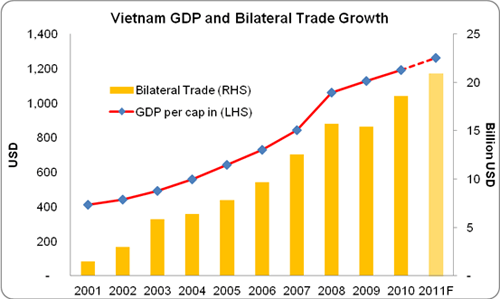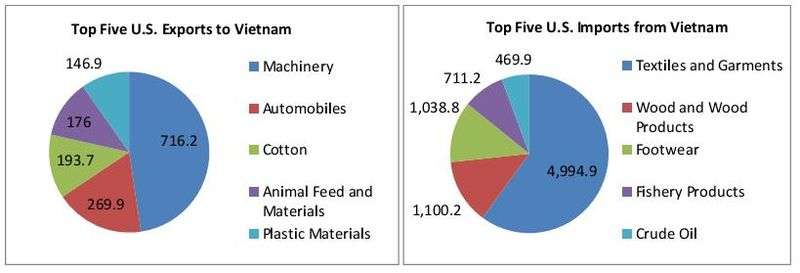United States–Vietnam trade relations
U.S. - Vietnam Trade Relations refer to the bilateral trade relationship between the United States of America (U.S.) and the Socialist Republic of Vietnam (Vietnam) from 1990s to 2012. After more than two decades of no economic relationship since the end of the Vietnam War, the two governments reestablished economic relationship during the 1990s.[1] The bilateral trade between the U.S. and Vietnam grew slowly afterwards, and it has developed rapidly after the signing of the U.S.-Vietnam Bilateral Trade Agreement in December 2001.[2] Total bilateral trade turnover has increased 1200% from $1.5 billion in 2001 to over $20 billion in 2011.[3] The bilateral trade relations further developed after the U.S. granted Vietnam permanent normal trade relations (PNTR) status as part of Vietnam’s accession to the World Trade Organization (WTO) in 2007.[1] The U.S. and Vietnam also came to a Trade and Investment Framework Agreement (TIFA) in 2007.[4] Vietnam was recently the United States' 26th largest goods imports partner with $17.5 billion in 2011,[5] and was the 45th largest goods export market with $3.7 billion in 2010.[4] Vietnam with six other partners are now in the ongoing Trans-Pacific Partnership (TPP) negotiations with the U.S.[6] The growth in bilateral trade has also been accompanied by issues and problems, e.g. anti-dumping cases, worker’s rights, non-market economy, Intellectual Property Rights (IPR) protection and Vietnam’s exchange rate policy.[1]
History
The normalization process (1975- 2000)
After the Vietnam War ended in 1975, the U.S. and Vietnam maintained no economic relation in more than two decades.[1] Washington extended President Richard Nixon’s 1964 trade embargo to all of Vietnam [7] and all bilateral trade activities were prohibited.[1] The Ronald Reagan and George H.W. Bush Administrations’ joint efforts to resolve the remains of U.S. servicemen missing in action (MIA) had set the foundation for the normalization of bilateral trade relations between the two nations during the Clinton Administration.[1] On February 3, 1994, President Bill Clinton ordered the lifting of the U.S. trade embargo on Vietnam.[7] Three years later, in 1997, Pete Peterson was appointed as the first U.S. Ambassador to Vietnam since 1975.[7] The two governments signed the first bilateral trade agreement (BTA) on July 13, 2000.[7]
Key trade agreements and frameworks (2001-2012)
U.S.-Vietnam Bilateral Trade Agreement (BTA): The BTA went into force at a Blair House ceremony with Deputy Prime Minister Nguyen Tan Dung, Trade Minister Vu Khoan and U.S. Trade Representative Robert Zoellick on December 10, 2001.[8] The BTA extended to Vietnam “conditional most favored nation (MFN) trade status”,[1] also known as “normal trade relations” (NTR).[1] On December 29, 2006, President George W. Bush granted the permanent normal trade relations (PNTR) status to Vietnam which was part of Vietnam’s accession to the World Trade Organization (WTO).[8] Bilateral trade relations have developed more quickly since the signing of the BTA.[3] The U.S. government has approved annual appropriations with the amount of $4–5 million to support Vietnam’s economic reforms.[1]
U.S. - Vietnam Trade and Investment Framework Agreement (TIFA): Vietnam’s accession to WTO as the 150th member accelerated the process of addressing economic and legal reform issues in the U.S.-Vietnam Trade and Investment Framework (TIFA) negotiations.[6] Two governments concluded TIFA in 2007 (ustr). Since then, the U.S. and Vietnam’s representatives have met on a regular basis under the TIFA to discuss about the implementation process of Vietnam’s WTO commitments.[4]
Trans-Pacific Partnership (TPP): In 2010, together with six other partners (Brunei Darussalem, Chile, Malaysia, New Zealand, Peru, and Singapore), U.S. and Vietnam started the negotiations for a Trans-Pacific Partnership (TPP) regional free trade agreement.[4][9] The U.S. seeks to “develop a high-standard, 21st-century regional trade agreement that will support the creation and retention of jobs in the United States and promote economic growth”.[4] The goal of the TPP is to become a potential platform for “economic integration across the Asia-Pacific region that will advance United States’ and Vietnam’s economic interests”.[9] Awareness of TPP among Vietnamese political and business circles has been rising during Vietnam's economic turmoil, 2008-2013, leading to the Vietnamese government' stronger push for this membership.[10]
Trade figures
U.S. Trade in goods with Vietnam (from 1992-2011)
Table 1:U.S. Trade in goods with Vietnam (from 1992–2011)(in $ million)[11]
| Year | Exports | Imports |
|---|---|---|
| 2011 | 4,341 | 17,485 |
| 2010 | 3,709 | 14,868 |
| 2009 | 3,097 | 12,288 |
| 2008 | 2,789 | 12,901 |
| 2007 | 1,903 | 10,632 |
| 2006 | 1,100 | 8,567 |
| 2005 | 1,193 | 6,631 |
| 2004 | 1,106 | 5,275 |
| 2003 | 1,323 | 4,555 |
| 2002 | 580 | 2,394 |
| 2001 | 460 | 1,053 |
| 2000 | 368 | 821 |
| 1999 | 292 | 608 |
| 1998 | 274 | 554 |
| 1997 | 287 | 388 |
| 1996 | 617 | 332 |
| 1995 | 252 | 199 |
| 1994 | 173 | 50.5 |
| 1993 | 7.0 | 0.0 |
| 1992 | 4.6 | 0.0 |
U.S. Vietnam trade in total (2001-2011)
U.S.-Vietnam trade figures have grown in pace with Vietnam’s per capita GDP (see Chart 1)[12]

U.S.-Vietnam trade products (2009)
(see Chart 2)[9]

Trade issues
The growth in bilateral trade between the U.S. and Vietnam has also been accompanied by many issues and problems.[1] During Vietnam’s application to the U.S. Generalized System of Preferences (GSP) program and negotiation of a Bilateral Investment Treaty (BIT) with the U.S., U.S government has hesitated in accepting Vietnam’s application and in concluding a BIT with Vietnam.[1] The rapid increase in the imports of specific products from Vietnam (e.g. clothing, frozen fish fillets) have led to the creation of a controversial import monitoring program in the U.S., and to anti-dumping ruling against Vietnam.[1]
The 111th U.S. Congress has included “workers’ rights, the designation of Vietnam as a non-market economy, intellectual property rights (IPR) protection, and Vietnam’s exchange rate policy” as the most prominent economic issues which influence relations between the U.S. and Vietnam.[1] Two governments is now seeking to resolve the preceding issues in recent meetings under the TIFA.[4]
See also
References
- 1 2 3 4 5 6 7 8 9 10 11 12 13 Martin, Michael F. "U.S.-Vietnam Economic and Trade Relations: Issues for the 111 Congress" (PDF). CRS Report for Congress. Congressional Research Service. Retrieved 4 March 2012.
- ↑ BBC Vietnamese (Thứ năm, 8 tháng 12, 2011). "http://www.bbc.co.uk/vietnamese/business/2011/12/111208_usvn_trade_10_years.shtml". BBC Vietnamese. Retrieved 4 March 2012. Check date values in:
|date=(help); External link in|title=(help) - 1 2 BBC Vietnamese (thứ năm, 8 tháng 12, 2011). "Thương mại Mỹ - Việt tăng 1200% sau 10 năm". BBC Vietnamese. Retrieved 4 March 2012. Check date values in:
|date=(help) - 1 2 3 4 5 6 Office of the United States Trade Representatives. "Vietnam". Retrieved 4 March 2012.
- ↑ International Trade Administration. "Top U.S. Trade Partners". Department of Commerce.
- 1 2 Hormats, Robert D. (April 12, 2010). "The U.S.-Vietnam Economic Relationship". U.S. Department of State. Retrieved 4 March 2012.
- 1 2 3 4 U.S. Vietnam Trade Council. "Chronology of US-Vietnam Relations (As of November 9, 2010)" (PDF). Retrieved 4 March 2012.
- 1 2 Vietnam Trade Office in the USA. "Milestones in Vietnam-U.S. Economic and Trade Relations". Retrieved 4 March 2012.
- 1 2 3 Embassy of the United States Hanoi, Vietnam. "U.S.-Vietnam Bilateral Economic Relations: 15 Years of Success". Retrieved 4 March 2012.
- ↑ Napier, Nancy K.; Vuong, Quan Hoang (2013). What we see, why we worry, why we hope: Vietnam going forward. Boise, ID, USA: Boise State University CCI Press. p. 140. ISBN 978-0985530587.
- ↑ U.S. Census Bureau. "Trade in Goods with Vietnam". U.S. Census Bureau. Retrieved 4 March 2012.
- ↑ "U.S. and Vietnam Celebrate 10th Anniversary of Bilateral Trade Agreement (BTA)". Embassy of the United States Hanoi, Vietnam. December 9, 2011. Retrieved 4 March 2012.
External links
- Bilateral Trade Agreement to Normalize Trade Relations with Vietnam: Text of the Agreement
- International Trade Administration, Department of Commerce
- U.S.-Vietnam Trade Council
- Embassy of the United States in Hanoi
- Vietnam Trade Office in the United States of America
- American Chamber of Commerce in Vietnam